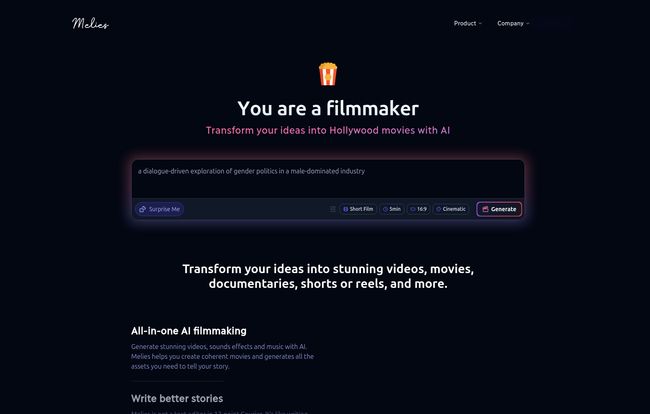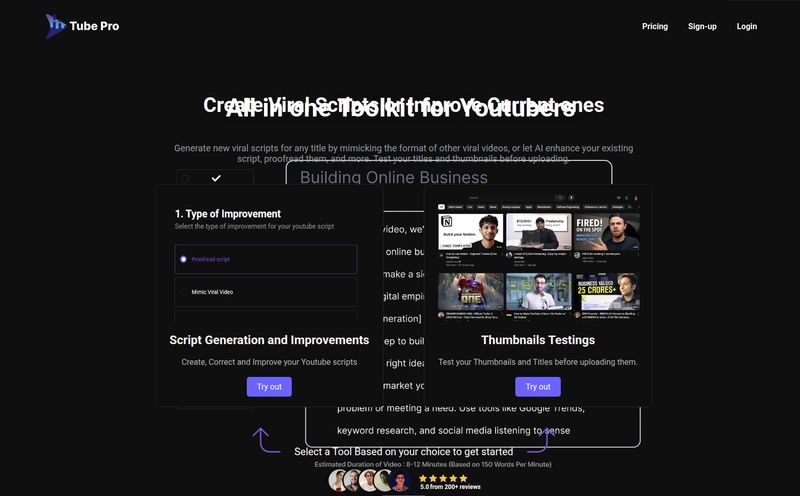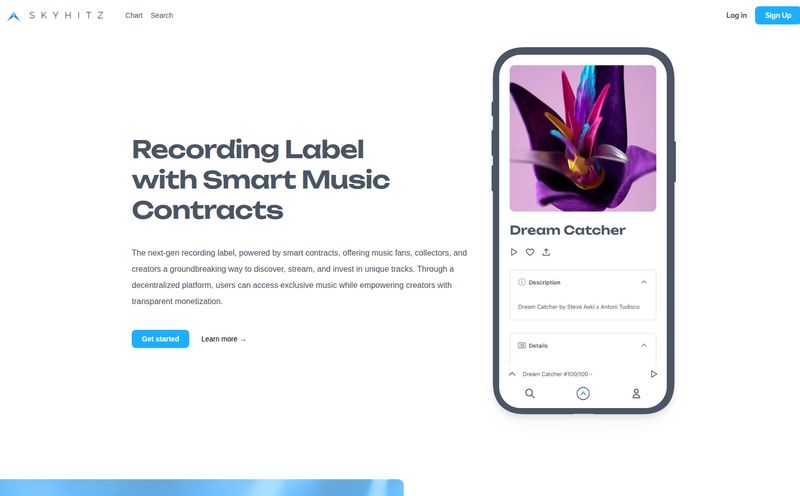For the last couple of years, my browser tabs have been a chaotic mess of AI tools. One tab for a script polisher, three for different image generators (because you know, one just isn't good at hands), another two for the latest AI video platforms that promise the world, and a separate one for voice synthesis. It’s been a bit of a digital Wild West, hasn't it? We're all trying to wrangle these incredible, powerful new technologies into something… coherent. Something that tells a story.
Every so often, a tool comes along that tries to be the sheriff in this chaotic town. Enter Melies. And yes, if you're a film nerd like me, that name immediately makes your ears perk up. It’s a wonderful nod to Georges Méliès, the magician-turned-filmmaker who basically invented special effects with movies like A Trip to the Moon. A lofty name to live up to.
But Melies isn’t just another AI video generator. I’ve been digging into it, and its whole approach is different. It's less of a single tool and more of an... AI filmmaking conductor. It doesn't want to be the best violin; it wants to be the one that gets the entire orchestra to play in tune. And I have to say, I'm intrigued.
So, What Exactly is Melies? More Than Just an AI Video Generator
Here’s the core idea that got me hooked: Melies doesn't try to build every single AI model from scratch. Instead, it acts as a smart, unified dashboard that integrates some of the best-in-class Generative AI tools already out there. Think of it like this: you have a single studio environment where your scriptwriter (powered by Anthropic's Claude), your concept artist (powered by Midjourney), your cinematographer (powered by Runway or Pika), and your sound designer (powered by ElevenLabs) are all working together under one roof. Your roof.

Visit Melies AI
This, for me, solves one of the biggest headaches in AI content creation: the fragmented workflow. No more downloading a PNG from one site, uploading it to another, tweaking a prompt, exporting an MP4, then trying to sync it with some AI-generated audio in a third-party editor. Melies aims to bring all of that into one place. It’s an ambitious goal, and one that could genuinely change the game for indie creators.
The Filmmaking Workflow, Reimagined with AI
Let's walk through how this might actually work for a project. You’ve got an idea buzzing in your head—a dialogue-driven exploration of gender politics in a male-dominated industry, as their homepage example suggests. Or maybe something simpler, like a cat detective noir. Whatever it is, you start with the story.
From Vague Idea to Coherent Script
Melies integrates powerful text generation models to help you go from a one-line concept to a full-fledged script. This isn't just about generating dialogue. It's about structuring your story, developing plot points, and crafting character arcs. I've always felt that AI is at its best when it's a collaborator, a sort of tireless writing partner who never gets bored of hearing “what if we tried this instead?”. This is the first step, and it’s the foundation for everything that follows.
Creating Your Cast with Consistent Characters
Okay, this is a big one. Anyone who's tried to make a sequential story using AI image generators knows the absolute pain of character consistency. You get a perfect shot of your hero, “Cyber-Detective Rick,” and in the next frame, he suddenly has a different jawline, an extra finger, and his trench coat has turned into a hoodie. It’s a huge immersion-breaker. Melies puts a major focus on solving this, allowing you to define your characters and maintain their look across different scenes and shots. For any narrative project, this feature isn’t just nice to have; it’s absolutely essential.
The Magic of Generation: Video, Images, and Sound
Once your script is solid and your characters are defined, it’s time to make the movie. This is where the “orchestra” comes in. Melies gives you access to a suite of generation tools for video, stills, sound effects and music. You can generate a sweeping establishing shot, a dramatic close-up, the sound of rain hitting a window pane, and a moody synth score, all within the same ecosystem. This integration is the secret sauce. The ability to quickly iterate—to generate a shot, see it in context, and then immediately tweak the prompt or generate an accompanying sound effect—is something that would have sounded like science fiction just a few years ago.
The All-Important Question: Melies Pricing and The Credit System
This all sounds great, right? But what’s it gonna cost? This is where we need to get practical. Melies operates on a subscription model with a credit system, which is pretty common in the AI space. Let’s break it down.
| Plan | Price per Month | Credits per Month | Best For |
|---|---|---|---|
| Indie | $29 | 2,500 | Your first short film or experimenting. |
| Filmmaker | $99 | 10,000 | Serious creators working on multiple/longer projects. |
| Studio | $390 | 50,000 | Power users, small agencies, or prolific filmmakers. |
Now, the credits. This is where you need to pay attention. Every action costs a certain number of credits. Generating text with Claude 3.5 Sonnet might cost 15 credits, while generating a 4-second video clip with Runway Gen-2 costs 100 credits. The pricing page has a neat “AI Film Cost Calculator” that gives you a rough idea. For a 3-minute film, it estimates a total of around 2,910 credits, which puts you just over the Indie plan's monthly allowance.
Here’s the rub, and my biggest personal hesitation: credits don’t roll over. If you have 1,000 credits left at the end of your billing cycle, they just… vanish. I get the business model, it encourages consistent use. But as a creator, it can feel a little punishing, especially if you have a busy month and can't dedicate as much time to a project. It’s something to be very aware of before you subscribe.
The Good, The Bad, and The AI-Generated
So, let's boil it all down. No tool is perfect, especially not in this rapidly changing space.
The advantages are obvious and powerful. Having the best AI tools for scriptwriting, character design, video generation, and sound all in one place is a massive workflow improvement. The focus on story and character consistency shows they understand what filmmakers actually need. It’s not just about creating cool-looking clips; it’s about creating coherent narratives.
On the flip side, the credit system is a double-edged sword. While it provides access to expensive models, the “use it or lose it” policy on credits is a definite con for me. Your costs can also ramp up quickly if you’re doing a lot of video generation, which is by far the most credit-intensive part of the process. You're also at the mercy of the underlying models; if Midjourney is having an off day with its aesthetics, that will carry through into your Melies project.
Who is Melies Actually For?
In my opinion, Melies is tailor-made for the ambitious one-person-band filmmaker. The storyteller who has a clear vision but lacks the million-dollar budget, the film crew, the location permits, and the post-production house. It's for the YouTuber who wants to create a narrative series, the author who wants to create a trailer for their book, or the indie filmmaker who wants to produce an entire animated short from their laptop.
It might not be for the absolute beginner who is just dipping their toes into AI for the first time—the credit system requires some planning. And it's probably not for the big-budget studio that already has established pipelines. But for that hungry, creative middle ground? It could be a revolution.
My Final Thoughts
Is Melies the ultimate, final form of AI filmmaking? No, of course not. We're still in the first few minutes of this movie. But is it a massive step in the right direction? Absolutely. By focusing on integration and workflow instead of just a single, flashy feature, Melies is addressing the real, practical challenges that creators are facing right now.
It’s turning a jumble of powerful but disconnected tools into a cohesive, story-driven studio. It’s making the impossible, or at least the impossibly expensive, accessible. And just like its namesake, it’s giving creators a new set of magic tricks to bring their wildest ideas to life. I, for one, am excited to see the films that come out of it.
Frequently Asked Questions
- What are credits in Melies and how do they work?
- Credits are the currency you use within Melies to perform actions. Different actions, like generating text, images, or video clips, cost a different number of credits depending on the complexity and the underlying AI model used. You get a set number of credits each month with your subscription.
- Can I purchase additional credits if I run out?
- Yes, according to their FAQ, you can purchase additional credits if you run out before your next billing cycle. This is useful for finishing a project that requires a bit more generation than you initially planned for.
- Do credits roll over to the next month?
- No, this is a key point to remember. Unused credits expire at the end of your monthly billing cycle and do not roll over. You'll need to plan your usage accordingly to get the most value from your subscription.
- Is there a free trial for Melies?
- The pricing page doesn't explicitly mention a free trial. It's best to check the Melies website directly for the most current offers, as platforms like this sometimes introduce trials or special promotions.
- What are some of the AI models Melies integrates with?
- Melies integrates with a wide range of top-tier models, including Anthropic's Claude 3.5 Sonnet for text, Midjourney and FLUX 1 for images, Runway and Pika for video, and ElevenLabs for sound and voice synthesis.
- How does Melies handle character consistency?
- This is one of its core features. Melies has built-in tools that allow you to define a character's appearance and then reference that character throughout your project, ensuring they look consistent across different scenes and shots—a critical feature for any kind of storytelling.
Reference and Sources
- Melies Official Website
- Melies Pricing Page
- A Trip to the Moon (1902) by Georges Méliès - For a little historical inspiration!



